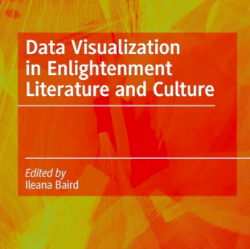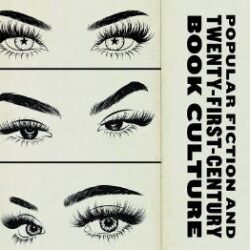In 1883, Jules Richard wrote that once a bibliophile has a collection of more than a thousand volumes, the room where they are kept quickly becomes a shrine – ‘devient vite un temple’. Reid Byers cites this observation (p. 4), and it reflects the central theme of his long and interesting book. He opens with a discussion of the simple rooms that held the clay tablets of Sumer and Babylon, and describes the book-boxes in which the Egyptians and the early Greeks put their papyrus scrolls. The rooms in which these chests were kept define what Byers calls ‘type one’ libraries. Private collections seem to have existed by at least 1500 BCE in Egypt, and were relatively common among scholars by the time of the great philosophers of the Greek ‘Golden Age’.
Category: Book review
Ileana Baird, ed. Data Visualization in Enlightenment Literature and Culture.
Over ten finely documented and illustrated chapters, Ileana Baird and her twelve contributing writers offer scholars of the long eighteenth century (1660-c1800) a timely high-tech methodology: graphical conveyance of information. Baird’s new book, Data Visualization in Enlightenment Literature and Culture (2022), demonstrates the utility of content imaging. Baird and her writers have constructed datasets of research on selected topics in visually accessible designs: graphs, tables, figures, tabulations, charts, clustering, topic modeling, network graphs, data mapping,
Kim Wilkins, Beth Driscoll, and Lisa Fletcher. Genre Worlds: Popular Fiction and Twenty-First-Century Book Culture.
In 2017, I reviewed Jeremy Rosen’s exploration of genre and late 20th/21st century publishing in Minor Characters Have Their Day for SHARP News. So it seems only fitting that 5 years later I have the opportunity to review Genre Worlds: Popular Fiction and Twenty-First-Century Book Culture by Kim Wilkins, Beth Driscoll, and Lisa Fletcher. Genre Worlds is a more expansive examination of genre in popular fiction than the work of Rosen and many others, and provides an important framework for the study of genre fiction. Genre Worlds follows an organizational structure that addresses the theory of genre worlds, relationship to the publishing industry, transnational and transmedia genre worlds, community and creativity, genre sociality (online and in-person), the texts themselves, concluding with genre worlds and change.
James W. Watts and Yohan Yoo (eds.). Books as Bodies and as Sacred Beings.
The volume, edited by James W. Watts and Yohan Hoo, is a thought-provoking addition to our discipline as it expands the study on sacred texts by looking at them attaining the status of bodies, as well as body practices that merge with the materiality and immateriality of texts. Watts is a professor of religion who has focused on the rituals that surround scriptures. Many of the chapters are grounded on the three dimensions of sacred texts proposed by Watts himself: semantic, expressive or performative, and iconic. The first one refers to textual interpretation; the second to how a text gets materialized through the body by being read, memorized, sung or acted; while the last one refers to the material form and visual appearance of a text.
Simon Rowberry. Four Shades of Gray: The Amazon Kindle Platform.
Users of hardware such as the Kindle tend to have a preferred format, sometimes refusing to replace the device until it has completely gone beyond the point of use. This is just one of the phenomena that Simon Peter Rowberry hits on in his book Four Shades of Gray: The Amazon Kindle Platform (a nod to the greyscale used in the first Kindle back in 2007) as he delves into the inner workings of the Kindle, both as a platform and a larger tool in the Amazon ecosystem. This work balances the line in giving the reader valuable technical information, but remaining readable to most of the scholars, students, and publishers who will find merit in this book.





